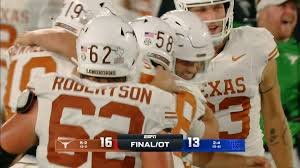A goal line stand is one of the purest expressions of grit, determination, and resilience in football. It’s where strength meets willpower, and each inch of turf becomes a battleground. When the Longhorns found themselves backed up against their own end zone, it wasn’t just about the scoreboard anymore—it was about identity. The fans, on their feet, breath held collectively in that massive stadium, knew what was at stake. The opposing team, surging with momentum, had driven down the field with authority. The clock was draining, pressure mounting, and everything pointed to the inevitability of a touchdown. But football isn’t about inevitability—it’s about execution.
Four plays. That’s all the Longhorns had to survive. First and goal from inside the three-yard line. The defensive line crouched low, eyes focused, muscles tensed like coiled springs. The first snap came, a power run up the gut. The running back, a bruiser who had been pounding the defense all night, took the handoff and plunged forward. But the Longhorns met him at the line. Linebackers flew in, plugging every gap, and the runner was swallowed for no gain. Second down.
On the next play, the quarterback faked a handoff and rolled out, looking to the flat. A tight end broke free, just for a second. The pass zipped toward him, but the linebacker, reading it all the way, laid a perfect hit as the ball arrived. Incomplete. The crowd roared with renewed hope. The third play was chaos. A shotgun snap. The quarterback, under pressure, tried to scramble. He ducked a rusher, spun left, and lunged toward the pylon. But a safety came flying in, launching himself low and cutting the quarterback down just short of the goal line. Fourth down.
This was it. The game, the season, maybe even the championship hopes balanced on this one snap. Everyone in the stadium could feel the weight of the moment. The opposing team lined up in jumbo. No tricks, no misdirection—just a challenge laid bare: beat us, man on man. The snap came. The runner surged forward, met instantly by a wall of burnt orange. Pads popped. Cleats scraped. For a heartbeat, time froze.
And then came the roar.
He was short.
The Longhorns had held.
The defense, exhausted but elated, stormed off the field, fists pumping, some falling to their knees in a mix of relief and triumph. Coaches embraced, fans screamed, and the sideline ignited in pure chaos. But there was still a problem. They were backed up deep, with time still on the clock. A safety or a turnover here would hand the game right back. So the offense jogged onto the field, steadying their nerves. This was about more than celebrating a stop—it was about finishing the job.
They bled the clock, inch by inch. A couple of quick runs gave them breathing room. A gutsy play-action pass on third down moved the chains. Now, the field was theirs to control. The offensive line, after spending the game locked in a brutal trench war, found new energy. They began to open holes, dominate the line, and grind the opponent down.
The quarterback, calm as ever, orchestrated the drive with precision. They didn’t need heroics—just composure. Every first down chipped away at the opponent’s hope. And as the seconds ticked down into the final minute, the Longhorns crossed midfield. The opponent had used all their timeouts. It was clear now: a field goal would ice it.
Out came the kicker. The stadium, once a roaring inferno of sound, now held its breath. The kicker paced backward, eyes fixed on the uprights. The long snapper set, the holder crouched. The snap came—clean. The hold—perfect. The kick—true.
The ball sailed through the night sky, spinning end over end. The arc was pure. The moment it left his foot, the sideline erupted. The officials raised their arms. It was good.
That field goal didn’t just add points—it declared victory. It was the punctuation mark on a night of fight, a night that tested the Longhorns in every way. From the defensive stand to the grinding offensive drive, to the dagger of a kick, this was football in its most primal and poetic form.
The final whistle blew, and the stadium exploded. Players threw helmets skyward, students stormed the field, and the burnt orange banners waved proudly into the night. The victory didn’t come from flash or flair—it came from resolve, unity, and execution. It came from every practice, every lift, every film session. It came from belief.
And belief is what defines great teams. Not just belief in winning, but belief in each other. Belief that when the stakes rise and the walls close in, they’ll find a way. That’s what the goal line stand meant. That when their backs were against it, they stood tall. Not because they were asked to, but because it was who they were.
In the locker room, the mood was electric. Music blared, chants echoed, and coaches walked with pride. But beneath the surface celebration was a quiet understanding—this game, this win, was a turning point. Not every victory galvanizes a team, but some wins reveal what a team truly is. This was one of those. A win earned, not given. Every player, from the starters to the scout team, had a piece of it. Every coach, every trainer, every fan who stood and screamed on fourth down contributed to it.
Later, when the press conferences were done and the stadium lights dimmed, a few players lingered on the field. They walked to the goal line, quiet now, almost reverent. They stood where history had just been made and let it soak in. These were moments they would carry for life. Moments that define a season, sometimes even a legacy.
Because what is football if not a collection of moments? Not every game goes into the record books. Not every win is remembered. But some? Some become stories, passed down from class to class, year to year. The night the Longhorns made a stand and sealed it with a kick will live on. It will be shown in highlight reels and recounted in tailgate tales. It will be used by coaches to teach grit and by fans to remember why they believe.
And the Longhorns believed. Even when the scoreboard was tight, even when the defense had to dig deep, even when the offense had to drain every last ounce of energy to finish the drive. They believed they could win. They believed they would win.
That belief turned into steel on that goal line. It turned into precision on that drive. And it turned into history with that field goal.
It wasn’t just a game—it was a declaration. A message to the rest of the league that this team isn’t backing down. That when the game is on the line, they don’t flinch. They fight. And when the dust settles, more often than not, they win.
The scoreboard read like any other win—final score: Longhorns ahead. But to those who watched, those who felt every hit, every cheer, every breathless pause, it meant so much more. It was heart. It was character. It was Texas football at its best.
So yes, the goal line stand and the field goal led the Longhorns to the win. But the story is bigger than that. It’s about a team that refused to break. It’s about the power of unity and the strength of belief. And above all, it’s about the moments that remind us why we watch, why we cheer, and why this game continues to move us.
Because sometimes, one stand and one kick is all it takes to change everything.



